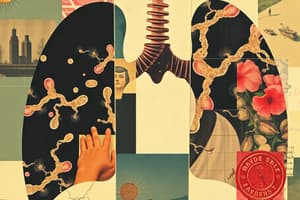Podcast
Questions and Answers
What is a characteristic feature of tuberculous ulcers in the terminal ileum?
What is a characteristic feature of tuberculous ulcers in the terminal ileum?
- They are arranged longitudinally
- They have undermined edges (correct)
- They have sharp edges
- They have everted edges
What is the primary site of infection in primary intestinal tuberculosis?
What is the primary site of infection in primary intestinal tuberculosis?
- Mesentery
- Caecum
- Payer's patches (correct)
- Terminal ileum
What is the fate of primary intestinal tuberculosis in terms of spread?
What is the fate of primary intestinal tuberculosis in terms of spread?
- It only spreads lymphatically
- It doesn't spread at all
- It only spreads hematogenously
- It can spread both directly and lymphatically, as well as hematogenously (correct)
What is the most common complication of tuberculous ulcers?
What is the most common complication of tuberculous ulcers?
What is the aetiology of secondary intestinal tuberculosis?
What is the aetiology of secondary intestinal tuberculosis?
What is the characteristic arrangement of tuberculous ulcers in the terminal ileum?
What is the characteristic arrangement of tuberculous ulcers in the terminal ileum?
What is the pathology of primary intestinal complex?
What is the pathology of primary intestinal complex?
What is the consequence of fibrosis in intestinal tuberculosis?
What is the consequence of fibrosis in intestinal tuberculosis?
What is a rare complication of intestinal tuberculosis?
What is a rare complication of intestinal tuberculosis?
What is the characteristic feature of caseous necrosis in intestinal tuberculosis?
What is the characteristic feature of caseous necrosis in intestinal tuberculosis?
Flashcards are hidden until you start studying
Study Notes
Granuloma (TB)
- Tuberculosis is a chronic infective granuloma caused by Mycobacterium tuberculosis, also known as tubercle bacilli (human and bovine).
- Mycobacterium tuberculosis is a non-motile, acid-fast, and alcohol-fast organism that is very resistant but easily killed by sunlight.
- The pathological changes depend on the chemical structure of the bacteria, which consists of three components: a lipid fraction (capsule), a protein fraction (tuberculoprotein), and a small polysaccharide fraction.
Predisposing Factors
- Poverty
- Malnourishment
- Poor living conditions
- Lack of medical care or debilitating/immunosuppressive conditions
Route of Infection
- Inhalation (commonest method)
- Ingestion of raw milk contaminated with bovine or human bacilli, infecting the tonsils or intestine
- Skin inoculation by handling infected materials (rare)
Tubercle Formation
- Type IV hypersensitivity reaction
- Polysaccharide fraction of tubercle bacilli attracts neutrophil leucocytes within a few hours
- Lipid fraction of the capsule attracts macrophages, which phagocytose free bacilli (epitheloid cells)
- Bacilli are partially digested, releasing tuberculoprotein, which stimulates a cell-mediated immune response within 10 days
Macroscopic Picture
- Tubercles fuse to form small rounded gray follicles (1-2 mm in diameter)
- Caseation occurs, making the lesion appear pale yellow and cheesy in consistency
Pathogenesis
- Proliferative reaction (inflammatory cells)
- Exudative reaction (excess inflammatory fluid exudate)
Fate of Tubercle
- High immunity: small foci are completely fibrosed, large foci are capsulated by fibrous tissue with central caseating part showing dystrophic calcification
- Low immunity: direct spread, lymphatic spread, blood spread, or intracanalicular spread
Pulmonary Tuberculosis
- Primary pulmonary tuberculosis: first infection of the lung with tubercle bacilli, often in children, caused by inhalation of human bacilli
- Secondary pulmonary tuberculosis: tuberculous infection in a previously sensitized individual with lowered immunity
Primary Pulmonary Complex
- Triad of:
- Ghon's focus (yellowish lesion, 1-1.5 mm in diameter, commonly subpleural)
- Tuberculous lymphangitis (chain of tubercles along lymphatic vessels)
- Tuberculous lymphadenitis (enlarged hilar lymph nodes with caseating tubercles)
Fate of Primary Pulmonary Complex
- Healing: small lesion heals by complete fibrosis, bigger one heals by dystrophic calcification
- Spread: direct spread (tuberculous pneumonia, pleurisy), haematogenous spread (small number of bacilli: destroyed, moderate number: isolated organ tuberculosis, large number: miliary tuberculosis), or encapsulation and reactivation
Secondary Pulmonary Tuberculosis
- Infection: exogenous (inhalation of human bacilli) or endogenous (reactivation of a capsulated primary focus)
- Pathological features: start at the apex of the lung, commonly the right
- Course: regression (fibrotic tuberculosis), progression (chronic fibrocaseous pulmonary tuberculosis or acute fatal bronchopneumonia and acute caseous pneumonia)
Intestinal Tuberculosis
- Primary intestinal tuberculosis: due to ingestion of bovine bacilli in milk, forming a primary complex usually at the terminal ileum
- Secondary intestinal tuberculosis: due to swallowing infected sputum in patients with chronic fibrocaseous tuberculosis
Primary Intestinal Complex
- Intestinal lesions: tubercles in the Peyer's patches at the terminal ileum (minimal ulcers)
- Tuberculous lymphangitis and lymphadenitis (tabes mesentaris)
Fate of Primary Intestinal Complex
- Localization
- Spread: direct and lymphatic (tuberculous peritonitis), or hematogenous spread (isolated organ or miliary tuberculosis)
Complications of Intestinal Tuberculosis
- Intestinal hemorrhage
- Intestinal fistula
- Perforation of ulcers leading to septic peritonitis
- Spread of infection (direct and lymphatic or blood spread)
- Fibrosis leading to intestinal obstruction
- Secondary amyloidosis
Studying That Suits You
Use AI to generate personalized quizzes and flashcards to suit your learning preferences.




